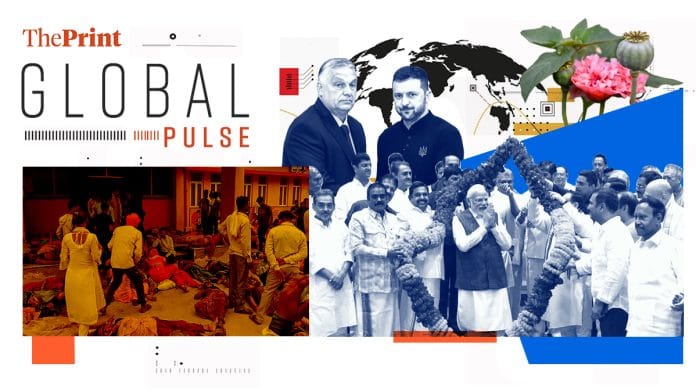New Delhi: The BJP’s rise since 2014 has ushered in a new era, representing a major shift from the pluralistic and federal principles of India’s first republic, established in 1950, writes author Milan Vaishnav in his piece, ‘The rise of India’s second republic‘.
The dominant trend now is re-centralisation under a series of ‘One Nation’ policies, which question the Constitutional premise that India is a union of states, writes Vaishnav in his piece, published in Johns Hopkins University’s Journal of Democracy.
Vaishnav writes that the BJP’s rise has brought about two realisations — “women are a vital constituency” and “the electoral irrelevance of the Muslims”. “In the emerging new republic, majoritarian will is regularly invoked to attribute democratic legitimacy to all governmental actions, even when they are illiberal,” he writes.
Vaishnav further highlights the “demise of secularism”, noting that “India’s current leaders embrace the notion of Hindutva (literally, ‘Hindu-ness’), in which loyalty to the Hindu nation is the defining virtue of citizenship”.
“In India, stampedes during religious pilgrimages are relatively common, often because of poor enforcement of public safety measures,” says The New York Times report on the stampede at a religious gathering in Hathras. Correspondents Suhasini Raj, Sameer Yasir, and Hari Kumar highlight the 116 deaths and 150 hospitalisations and unverified videos showing “a large number of dead bodies, mostly those of women”.
The report points out that the crowd at Bhole Baba’s meeting in Hathras was larger than initially permitted, as well as the contradicting accounts of what led to the stampede. “Heat and overcrowding had set off a panic”, write the reporters, quoting eyewitnesses as saying that “some of the victims had fallen into a drainage ditch on top of one another”.
A coalition government will limit Modi’s domestic agenda, but it is unlikely to alter India’s foreign policy approach, writes Sumit Ganguly in a report in Foreign Policy.
The piece claims that “Modi and the BJP sought to use international engagement to convey nationalist messages about India’s growing prominence in the world” and that the establishment will likely maintain its “prideful posture”. The Indian presidency of the G20 was used to “showcase Modi’s clout” and when Western governments criticised India’s democratic practices, officials dismissed it as resentment over India’s rise, writes Ganguly.
The “returning team” of Modi’s cabinet will likely maintain its relations with the United States and continue to keep a close eye on China and deepen defence ties while reassessing India’s long-standing partnership with Moscow, he writes. “India will continue to pursue its interests in the rest of South Asia, Southeast Asia, and Central Asia without much change,” adds Ganguly.
A report — ‘Northeast India’s battle against drugs‘ — by Sajal Nag examines the escalating drug problem in India’s northeastern states and its implications for the country’s security. India’s northeastern states “have historically been associated with the cross-border drug trade whose origins are linked to the ‘Golden Triangle’ with Myanmar at the center of this international narcotics-fuelled economy”, Nag writes.
Despite efforts of vulnerable mapping, high-tech surveillance, and restrictions on cross-border movement, the menace, he writes, has not receded. “Before the BJP won in 2014, drug trafficking efforts were ineffective, with few seizures,” writes Nag, crediting the Modi government’s “zero tolerance policy” for the destruction of a significant amount of narcotics and the increase in drug trafficking arrests between 2014 and 2022.
Hungary’s Orban visits Ukraine, AI drives up Google’s emissions
Hungarian Prime Minister Victor Orban has landed unannounced in Kyiv. A strong critic of the Western support to Ukraine in the war against Russia, the NATO member has urged a ceasefire between the two nations. To know more, read BBC’s report.
In its 2024 Environment report, Google has revealed that it has taken a step back on its path to net-zero emissions by 2030 due to a 50 percent increase in carbon emissions owing to the increased energy demand by Artificial Intelligence. To learn more, read this CNBC report.
(Edited by Madhurita Goswami)






